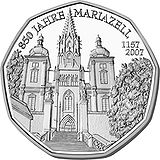
Mariazell Basilica
Encyclopedia
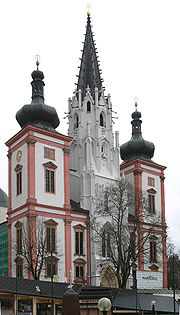
English language
English is a West Germanic language that arose in the Anglo-Saxon kingdoms of England and spread into what was to become south-east Scotland under the influence of the Anglian medieval kingdom of Northumbria...
the Basilica of the Birth of the Virgin Mary) is a Marian basilica
Roman Catholic Marian churches
Throughout history, Roman Catholics have built churches to venerate the Blessed Virgin Mary. Today, a large number of Roman Catholic churches dedicated to the Blessed Virgin exist on all continents...
in Mariazell
Mariazell
Mariazell is a small city in Austria, in Styria, well known for winter sports, 143 km N. of Graz. It is picturesquely situated in the valley of the Salza, amid the north Styrian Alps....
, Austria
Austria
Austria , officially the Republic of Austria , is a landlocked country of roughly 8.4 million people in Central Europe. It is bordered by the Czech Republic and Germany to the north, Slovakia and Hungary to the east, Slovenia and Italy to the south, and Switzerland and Liechtenstein to the...
. It is the most important pilgrimage
Pilgrimage
A pilgrimage is a journey or search of great moral or spiritual significance. Typically, it is a journey to a shrine or other location of importance to a person's beliefs and faith...
destination in Austria and one of the most visited shrines in Europe. In the church, a miraculous wooden image of the Virgin Mary is honored.
Early history
The territory around MariazellMariazell
Mariazell is a small city in Austria, in Styria, well known for winter sports, 143 km N. of Graz. It is picturesquely situated in the valley of the Salza, amid the north Styrian Alps....
was given to the Monastery of St. Lambrecht around 1103, and the monks built cells there in order to serve the local residents. Legends give the town's founding day as December 21, 1157, but it is first documented in 1243. A Marian altar was dedicated there in 1266.
The Basilica of the Mariä Geburt
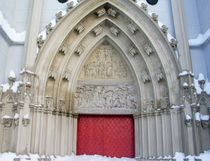
Ogive
An ogive is the roundly tapered end of a two-dimensional or three-dimensional object.-Applied physical science and engineering:In ballistics or aerodynamics, an ogive is a pointed, curved surface mainly used to form the approximately streamlined nose of a bullet or other projectile.The traditional...
portal. In 1420 and 1474, the church was destroyed by fire. The church building was later expanded and baroque
Baroque
The Baroque is a period and the style that used exaggerated motion and clear, easily interpreted detail to produce drama, tension, exuberance, and grandeur in sculpture, painting, literature, dance, and music...
-ified by Domenico Sciassia from 1644 to 1683. To the left and right of the gothic spire a baroque tower was built, the nave was lengthened and widened, and a dome was added on the eastern side. The high altar, consecrated in 1704, was designed by Johann Bernhard Fischer von Erlach
Johann Bernhard Fischer von Erlach
----Johann Bernhard Fischer von Erlach, born Johann Bernhard Fischer was probably the most influential Austrian architect of the Baroque period....
.
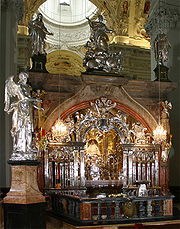
Vienna
Vienna is the capital and largest city of the Republic of Austria and one of the nine states of Austria. Vienna is Austria's primary city, with a population of about 1.723 million , and is by far the largest city in Austria, as well as its cultural, economic, and political centre...
sculptor Johann Wagner in 1740.
In front of the main entrance are two life-sized lead statues created by Balthasar Moll in 1757. To the left stands King Ludwig I of Hungary
Hungary
Hungary , officially the Republic of Hungary , is a landlocked country in Central Europe. It is situated in the Carpathian Basin and is bordered by Slovakia to the north, Ukraine and Romania to the east, Serbia and Croatia to the south, Slovenia to the southwest and Austria to the west. The...
and to the right is Heinrich, Margrave
Margrave
A margrave or margravine was a medieval hereditary nobleman with military responsibilities in a border province of a kingdom. Border provinces usually had more exposure to military incursions from the outside, compared to interior provinces, and thus a margrave usually had larger and more active...
of Moravia
Moravia
Moravia is a historical region in Central Europe in the east of the Czech Republic, and one of the former Czech lands, together with Bohemia and Silesia. It takes its name from the Morava River which rises in the northwest of the region...
.
In 1907, the pilgrimage church was elevated to a basilica minor.
The basilica has been undergoing a general restoration since 1992, which is expected to be completed in 2007.
Holy Image and Chapel
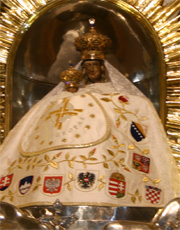
Romanesque art
Romanesque art refers to the art of Western Europe from approximately 1000 AD to the rise of the Gothic style in the 13th century, or later, depending on region. The preceding period is increasingly known as the Pre-Romanesque...
miraculous image of the Virgin Mary - the "Magna Mater Austria" - a 48 cm tall statuette made of linden
Tilia
Tilia is a genus of about 30 species of trees native throughout most of the temperate Northern Hemisphere. The greatest species diversity is found in Asia, and the genus also occurs in Europe and eastern North America, but not western North America...
.
Pilgrimage Development
Pilgrims were already making their way to the Marian sanctuary in the 12th century. Larger numbers of pilgrims are documented beginning around 1330, when a secular court imposed a "Zellfahrt" (Zell journey) as atonement for its criminals. In the following years increasing numbers of pilgrims came from neighboring lands. After the Counter-ReformationCounter-Reformation
The Counter-Reformation was the period of Catholic revival beginning with the Council of Trent and ending at the close of the Thirty Years' War, 1648 as a response to the Protestant Reformation.The Counter-Reformation was a comprehensive effort, composed of four major elements:#Ecclesiastical or...
, the Habsburgs made Mariazell a national sanctuary. However, in 1783, Emperor Joseph II
Joseph II, Holy Roman Emperor
Joseph II was Holy Roman Emperor from 1765 to 1790 and ruler of the Habsburg lands from 1780 to 1790. He was the eldest son of Empress Maria Theresa and her husband, Francis I...
dissolved the monastery in Mariazell, and in 1787, he completely banned pilgrimages there. After the early withdrawal of the restrictions, today around a million pilgrims visit Mariazell each year. In May 2004, the Central European Catholic Day (mitteleuropäische Katholikentag) took place there.
Legends
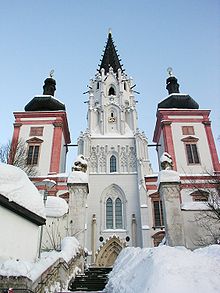
The legend of the towns founding says that in 1157, the St. Lambrecht Monk Magnus was sent to the area of the current town as a minister. When his way was blocked by a rock, he set down the Marian figurine he had brought with him, whereby the rock broke apart and left Magnus' way clear. On a nearby bank, he settled down, placed the figurine on a tree trunk, and built a cell out of wood, which served as both his chapel and his living quarters.
The second legend relates how Henry Margrave of Moravia and his wife, having been healed of severe gout through the help of Our Lady of Mariazell made a pilgrimage to that place around 1200. There they built the first stone church on the site of the wooden chapel.
The third legend recounts a victorious battle of the Hungarian King Ludwig I over a numerically superior Turkish army.
Out of thanks he built the gothic church and endowed it with the "Schatzkammerbild" ("treasury image") that he saw laid upon his chest in a dream.
